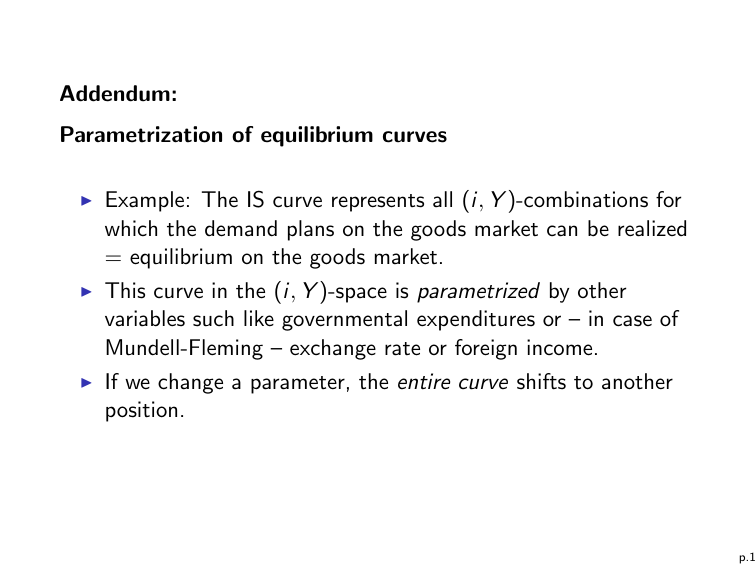Addendum: Parametrization of equilibrium curves Example: The IS
advertisement

Addendum: Parametrization of equilibrium curves ◮ Example: The IS curve represents all (i, Y )-combinations for which the demand plans on the goods market can be realized = equilibrium on the goods market. ◮ This curve in the (i, Y )-space is parametrized by other variables such like governmental expenditures or – in case of Mundell-Fleming – exchange rate or foreign income. ◮ If we change a parameter, the entire curve shifts to another position. p.1 Example: IS curve for a closed economy: Y = C a + cY + I (i) + G (1 − c)Y − C a = I (i) + G ◮ The curve in (i, Y )-space is parametrized by G . ◮ Let G increase. Then the right hand side increases, and the equality does not hold true anymore, i.e. the old IS curve is not valid anymore. ◮ Question: Does the IS curve shift to the left or to the right? In other words: which (i, Y )-combinations establish a new equilibrium? ◮ Answer: For a given Y we need a higher i (and thus lower I (i)) in order to equalize left and right hand side (because this compensates the higher G on the right side). Alternatively, for a given i we need a higher Y (because this increases the left side so that both sides are equal again). Graphically, this means that the IS curve shifts to the right. p.2 ◮ Note: These considerations have nothing to do with economic causalities as a consequence of the increased G ! We simply do not know what happens with Y or i in the economy as a consequence of increased G (this would require a model analysis e.g. including a LM curve). ◮ We are just analysing the location of an equilibrium condition! ◮ On the subsequent slide we consider the case of an open economy where the IS curve is additionally parametrized by the foreign income Y f and the exchange rate τ . ◮ Algebraically, this can be done by looking whether a shift of e.g. dY f > 0 would require a higher income (dY > 0) or a lower income (dY < 0) in order to have a goods market equilibrium if we keep the interest rate constant (di = 0). Alternatively, we could also investigate whether with a given income (dY = 0) a goods market equilibrium requires a higher interest rate (di > 0) or a lower (di < 0). p.3 ◮ Change of Y f : dY = CY dY + Ii di + XY f dY f + XY dY Keep i constant (di = 0): ⇒ XY f dY = >0 dY f 1 − CY − XY If Y f increases: right-shift of IS curve! ◮ Change of τ : dY = CY dY + Ii di + Xτ dτ + XY dY Keep i constant (di = 0): ⇒ Xτ dY = >0 dτ 1 − CY − XY If τ increases: right-shift of IS curve! p.4






